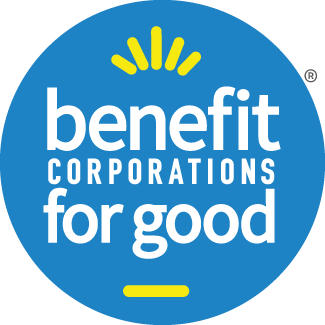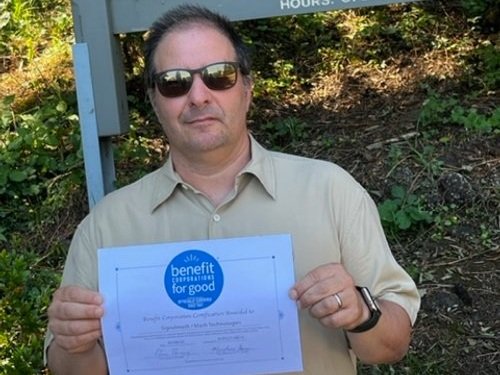How an Oregon Startup Is Putting Soul into the Tech World
Noah Kamrat is Co-founder and CEO of Signalmash and leader of a certified Benefit Corporation for Good. Certified BCFGs practice a triple bottom line of People, Planet and Profit.
From the get-go, the leadership team of the Signalmash brand at Mash Technologies asked themselves a simple question: “What does it mean to be a responsible tech company today?”
They found their answer with 3 simple words: People, Planet, Profit and the pillars of a benefit corporation.
Taking a triple bottom line approach to business made it easy to answer the hard questions of building a tech organization. If the action the company was evaluating didn’t also positively impact people and planet, the answer was a simple “no.”
It’s not a common way of doing business in the business world. But creating tech solutions and algorithms that empower people and add value to the community is what Mash Tech is all about.
We recently interviewed CEO Noah Kamrat about becoming a certified Benefit Corporation for Good. Here’s what he had to say about it, the motivation for doing it and why it was right for Signalmash.
1. What motivated you to become a Benefit Company?
We recently built a new organization and technology that fits the vision of being a Benefit Company. We believe that companies should consider their impact on all stakeholders, not just shareholders. We also believe in mutual respect and diversity, and think that tech is uniquely positioned to help solve the biggest challenges of the day. It was only natural for us to move towards obtaining a certification. Being a local company from Oregon, we heard about Benefit Corporations for Good (BCFG) and sought their help. They informed us of our choices and once we agreed to becoming certified, they made the process enjoyable.
Now that we are certified, we are part of a community of like-minded individuals. Also, BCFG has introduced us to leaders, set us up with podcast interviews and connected us with consultants. In turn, we offer discounts to BCFG’s community for messaging and programmatic voice as well as elastic SIP trunking. It is a win-win for everyone involved.
2. Was it difficult getting internal support for moving toward this model?
We have been adhering to the values behind this model long before we became a Benefit Company. So it was easy-peasy to get our team on board. Eventually we will hire more Millennials and they expect to work for companies who hold themselves accountable to bettering the lives and futures of humanity.
3. How long did it take you to officially become a Benefit Company?
We set up Mash Technologies as a Benefit Company in Oregon and sought to become certified by Benefit Corporation for Good shortly thereafter. Although the questions made us rethink some of the ways we were doing business and changes were made accordingly, we became a certified Benefit Company within a month.
4. Have you seen any change in culture since you became a Benefit Company?
From day one, we have operated with the purpose of creating a positive impact on society and the environment, in addition to being financially profitable. There were a few changes we made to Mash Technologies after becoming a Benefit Company. Mainly in the areas of social responsibility and sustainability, which the certification process highlighted we needed to improve in.
5. Have you experienced any positive outcomes since becoming a Benefit Company?
This is hard to measure but we have anecdotal evidence of increased engagement mostly through social media. People notice our mission-driven messaging and it helps us to distill a tighter brand – Signalmash.
6. Would you recommend this business model to others? Why or why not?
Yes, we have recommended this model to friends who run companies. Now more than ever, it is important to run a purpose-driven organization that aims at creating a positive impact in society. The greater number of businesses who adhere to the values behind Benefit Corporations for Good, the better positioned we are to bring meaningful change, collectively.
7. What is the most important trait to have as a conscientious leader of a Benefit Company?
Humility is the greatest trait to have as a conscientious leader. It is something that can be worked on in perpetuity. Along with humility is being open-minded and listening to other stakeholders.
8. What lessons have you learned in the process?
I’ve learned not to assume that everyone understands and sees things the way I do. It is important to engage with stakeholders and give them the space to share their experiences, concerns and goals.
9. Is being a Benefit Company part of your current brand message?
Our overall messaging is that we are a purpose-driven tech company that aims to create a better world for ourselves and generations to follow. We are proud to share that we are a certified Oregon Benefit Company, as it is a direct reflection of our beliefs and the values we stand for.
10. What is the single best reason you’d give for another company or peer to become a Benefit Company?
It is time to embrace a formal process and be committed to upholding the values of People, Planet and Profit. Benefit corporations have built into their charter non-financial, social impact goals. This allows Benefit Companies to have a more nuanced measure of success that includes all stakeholders (shareholders, employees, customers, communities and the environment). This is becoming a movement and is an intentional response to the traditional “fiduciary return of profit” to shareholders argument that businesses have used to justify profits above everything else.
You can learn more about Signalmash here.
If you want to know if your business is a good candidate to become a benefit corporation, take the free “sniff test” here.
And you can learn more about the 6 simple steps to becoming a certified triple-bottom-line company here.
~benefitcorporationsforgood.com~

